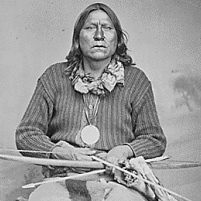National Parks Just Starting to Add the Stories of Native Americans
Saturday, September 10, 2011
 Satanta (White Bear), 3 days before Sand Creek Massacre
Satanta (White Bear), 3 days before Sand Creek Massacre
America’s national parks can be great learning tools, providing information to people of all ages about natural and man-made history. But when it comes to educating visitors about Native Americans, the parks still have a long ways to go.
At Indiana Dunes National Lakeshore, for example, the story of the Potawatomi tribe is told through the experiences of a white man, Joseph Bailly. There is no mention of the fact that the Potawatomi were forced west on a “Trail of Death.”
Some of the parks are now telling tales of local Indians, after completely ignoring them for generations. But even now, writes Robert Pahre for the Indian Country Today Media Network, the accounts are often incomplete or told “through the eyes of other people, the way it has been done it in too many movies.”
At Grand Teton National Park, a new visitors center features statues and text that include an American Indian woman, a prospector, a hiker, a photographer, a pioneer woman, a mountain climber and a tourist. “The Native woman is badly outnumbered, but she is there,” says Pahre.
Things are better at the recently established Sand Creek Massacre National Historic Site in Colorado, which acknowledges the slaughter of Indians at the site on November 29, 1864. The National Park Service (NPS) has worked with the Cheyenne and Arapaho on the project; the Indians also have been given access to the site for ceremonies. Additionally, NPS officials plan to remove a monument erected by locals in the 1950s that memorialized the soldiers who died during the massacre.
-Noel Brinkerhoff
No Longer Circling the Wagons: Many National Parks Get Indian Stories Wrong (by Robert Pahre, Indian Country Today Media Network)
- Top Stories
- Unusual News
- Where is the Money Going?
- Controversies
- U.S. and the World
- Appointments and Resignations
- Latest News
- Trump to Stop Deportations If…
- Trump Denounces World Series
- What If China Invaded the United States?
- Donald Trump Has a Mental Health Problem and It Has a Name
- Trump Goes on Renaming Frenzy






Comments